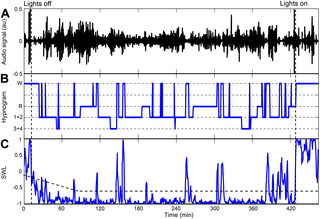This approach may simplify the diagnostic procedure and allow for natural sleep that is not affected by touch sensors and which can be used in the test at the subjects' home

As part of a research collaboration between the research laboratory for biomedical signal processing, headed by Dr. Yaniv Zigal from the Department of Biomedical Engineering at Ben-Gurion University of the Negev and the unit for the study of sleep-wake disorders, headed by Prof. Ariel Tersiuk, from the Soroka University Medical Center, an innovative system without sensors was developed Touch to assess the quality of sleep through the recording of breathing sounds during a night's sleep.
This study presents a groundbreaking new approach to sleep quality assessment using a microphone that does not touch the subject. Algorithms were developed for the signal analysis of breathing sounds that enabled the classification of sleep/wake states from a whole night's recording (see figure). The performance of this approach matches and even exceeds the performance of existing technologies for sleep evaluation that use touch sensors. This approach may simplify the diagnostic procedure and allow for natural sleep that is not affected by touch sensors and which can be used in testing at the subjects' home.
In the study, published in the journal PLoS One, the hypothesis was tested that sleep can be measured by analyzing the audio signals of breathing sounds. The idea behind this concept is that transitions from sleep to wakefulness and vice versa affect the control of breathing activity and air flow which are reflected in changes in the patterns of breathing sounds. This research is part of the doctoral thesis (PhD) of Mr. Eliran Dafna in the Department of Biomedical Engineering, Ben-Gurion University of the Negev.
As we know, good sleep is very essential for a satisfactory quality of life, for social interaction and intellectual activity. In modern society, many people do not sleep enough hours due to exposure to technologies such as watching TV, using the Internet and mobile phones. Poor sleep can cause morbidity and increase the risk of accidents - early diagnosis and treatment may improve the quality of life and reduce the chance of morbidity. The golden approach to testing for sleep disorders requires an overnight stay in the sleep laboratory (polysomnography test) and the installation of a wide variety of sensors. However, due to the high cost of laboratory sleep testing and the need for skilled personnel, the number of sleep laboratories is limited and many people are not diagnosed and treated. Biomedical engineering and sleep medicine are on a "fast track" towards the development of sleep tests that can be performed in the subjects' homes. At the moment, all existing home technologies are based on connecting subjects to touch sensors that often affect the quality of sleep. Hence the novelty and great importance of the development of the innovative system without touch sensors to assess the quality of sleep through the recording of breathing sounds during a night's sleep.
It should be noted that the Israeli industry is at the forefront of developing sensors for sleep tests in the laboratory and at home. This research has great potential for developing new scientific-technological directions that can be combined with existing technologies. The new technology can help increase the accessibility of sleep tests as well as monitoring the treatment of sleep disorders.
This research was supported by the Ministry of Economy, Office of the Chief Scientist, Kamin Program.

2 תגובות
Coming soon on the smartphone next to the bed.
correct approach